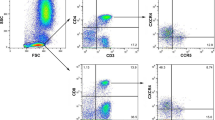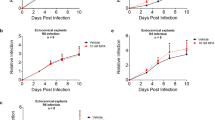Abstract
The upregulation of HIV-1 co-receptor expression during certain clinical settings may explain the predisposition of individuals to enhanced HIV-1 acquisition. We sought to determine the effect of estrogen and progesterone on the HIV-1 coreceptors, CCR5 and CXCR4. Co-receptor expression on CD3- and CD14-positive cells obtained systemically and locally (genital tissue in women) was determined in men, pre- and post-menopausal women, pregnant women in each trimester and in labor. CCR5 on both CD3- and CD14-positive cells was highest in pregnant women, and increased as gestation advanced (P < .01 and P < .001, respectively). Progesterone levels were significantly associated with CCR5 expression on PBMCs (P < .03 for CD3-positive, and P < .002 for CD14-positive cells) and from cells isolated from tissue (P < .001).CCR5 mRNA expression correlated with the cell suface marker expression from blood and tissue. These findings suggest that pregnancy and other high progesterone states may predispose women to HIV-1 acquisition.
Similar content being viewed by others
References
Martin JL Jr, Nyange PM, Richardson BA, et al. Hormonal contraception, sexually transmitted diseases, and risk of heterosexual transmission of human immunodeficiency virus type 1. J Infect Dis. 1998;178:1053–1059.
Ungchusak K, Rehle T, Thammapornpilap P, Spiegelman D, Brinkmann U, Siraprapasiri T. Determinants of HIV infection among female commercial sex workers in northeastern Thailand: results from a longitudinal study. J Acquir Immune Defic Syndr Hum Retrovirol. 1996;12:500–507.
Wang C, Reilly M, Kreiss J. Risk of HIV infection in oral contraceptive pill users: a meta-analysis. J Acquired Immune Defic Syndr. 1999;21:51–58.
Kiddugavu M, Makumbi F, Wawer MJ, et al. for the Rakai Project Study Group. Hormonal contraceptive use and HIV-1 infection in a population-based cohort in Rakai, Uganda. AIDS. 2003;17:233–240.
Plummer FA, Simonsen JN, Cameron DW, et al. Cofactors in male-female sexual transmission of human immunodeficiency virus type 1. J Infect Dis. 1991;163:233–239.
Lavreys L, Baeten JM, Martin HL Jr, et al. Hormonal contraception and risk of HIV-1 acquisition: results of a 10-year prospective study. AIDS. 2004;18:695–697.
Criniti A, Mwachari CW, Meier AS, et al. Association of hormonal contraception and HIV-seroprevalence in Nairobi, Kenya. AIDS. 2003;17:2667–2669.
Wang CC, McClelland RS, Overbaugh J, et al. The effect of hormonal contraception on genital tract shedding of HIV-1. AIDS. 2004;18:205–209.
Marx PA, Spira AI, Gettie A, et al. Progesterone implants enhance SIV vaginal transmission and early virus load. Nat Med. 1996;2:1084–1089.
Gray RH, Li Z, Kigozi G, et al. Increased risk of incident HIV during pregnancy in Rakai, Uganda: a prospective study. Lancet. 2005;366:1182–1188.
Taha TE, Dallabetta GA, Hoover DR, et al. Trends of HIV-1 and sexually transmitted diseases among pregnant and postpartum women in urban Malawi. AIDS. 1998;12:197–203.
Leroy V, Van de Perre P, Lepage P, et al. Seroincidence of HIV-1 infection in African women of reproductive age: a prospective cohort study in Kigali, Rwanda, 1988–1992. AIDS. 1994;8:983–986.
Ghanem KG, Shah N, Klein RS, et al. for the HIV Epidemiology Research Study Group. Influence of sex hormones, HIV status, and concomitant sexually transmitted infection on cervicovaginal inflammation. J Infect Dis. 2005;191: 358–386.
Whitelaw PF, Croy BA. Granulated lymphocytes of pregnancy. Placenta. 1996;17:533–543.
Clemens LE, Siiteri PK, Stites DP. Mechanism of immunosuppression of progesterone on maternal lymphocyte activation during pregnancy. J Immunol. 1979;122:1978–1985.
Mannel DN, Falk W, Yron I. Inhibition of murine cytotoxic T cell responses by progesterone. Immunol Lett. 1990;26:89–94.
White HD, Crassi KM, Given AL, et al. CD3+ CD8+ CTL activity within the human female reproductive tract: influence of stage of the menstrual cycle and menopause. J Immunol. 1997;158:3017–3027.
Piccinni MP, Guidi MG, Bisagittal R, et al. Progesterone favors the development of human T helper cells producing Th2-type cytokines and promotes both IL-4 production and membrane CD30 expression in established Th1 cell clones. J Immunol. 1995;155:128–133.
Vassiliadou N, Tucker L, Anderson DJ. Progesterone-induced inhibition of chemokine receptor expression on peripheral blood mononuclear cells correlates with reduced HIV-1 infectability in vitro. J Immunol. 1999;162:7510–7518.
Dalgleish AG, Beverly PCL, Clapham PR, Crawford DH, Greaves MF, Weiss RA. The CD4 (R4) antigen is an essential component of the receptor for the AIDS retrovirus. Nature. 1984;312:763–767.
Klatzmann D, Champagne E, Chamaret S, et al. T-lymphocyte T4 molecule behaves as the receptor for human retrovirus LAV. Nature. 1984;312:767–768.
McDougal JS, Kennedy MS, Sligh JM, Cort SP, Mawle A, Nicholson JKA. Binding of HTLV-II/LAV to T4+ T cells by a complex of the 110K viral protein and the T4 molecule. Science. 1986;231:382–385.
Feng Y, Broder CC, Kennedy PE, Berger EA. HIV-1 entry co-factor: functional cDNA cloning of a seven-transmembrane G protein-coupled receptor. Science. 1996;171:872–877.
Berson JF, Long D, Doranz BJ, Rucker J, Jirik FR, Doms RW. A seven transmembrane domain receptor involved in fusion and entry of T-cell tropic human immunodeficiency virus type-1 strains. J Virol. 1996;70:6288–6295.
Paxton WA, Dragic T, Koup RA, Moore JP. Perspective: research highlights at the Aaron Diamond AIDS Research Center. AIDS Res Hum Retroviruses. 1996;12:1203–1207.
Samson M, Labbe O, Mollereau C, Vassart G, Parmentier M. Molecular cloning and functional expression of a new CC-chemokine receptor gene, CC-CCR5. Biochemistry. 1996;11:3362–3367.
Dragic T, Litwin V, Allaway GP, et al. HIV-1 entry into CD4+ cells is mediated by the chemokine receptor CC-CXR-5. Nature. 1996;381:667–673.
Huang Y, Paxton WA, Wolinsky SM, et al. The role of a mutant CCR5 allele in HIV-1 transmission and disease progression. Nat Med. 1996;2:1240–1243.
Anderson DJ, Fichorova R, Haimovici F, Wang YM, Pudney J. B-chemokines and their receptors in the lower female genital tract. J Soc Gynecol Invest. 1997;4:201A.
Moore JP, Trkola A, Dragic T. Co-receptors for HIV-1 entry. Curr Opin Immunol. 1997;9:551–562.
Rottman JB, Ganley KP, Williams K, Wu L, Mackay CR, Ringler DJ. Cellular localization of the chemokine receptor CCR5: correlation to cellular targets of HIV-1 infection. Am J Pathol. 1997;151:1341–1351.
Choe H, Farzan M, Sun Y, et al. The β-chemokine receptors CCR3 and CCR5 facilitate infection by primary HIV-1 isolates. Cell. 1996;85:1135–1148.
Deng H, Liu R, Ellmeier W, et al. Identification of a major coreceptor for primary isolates of HIV-1. Nature. 1996;381: 661–666.
Bleul CC, Wu L, Hoxie JA, Springer TA, Mackay CR. The HIV coreceptors CXCR4 and CCR5 are differentially expressed and regulated on human T lymphocytes. Proc Natl Acad Sci USA. 1997;94:125–130.
Grivel JC, Margolis LB. CCR5- and CXCR4-tropic HIV-1 are equally cytopathic for their T-cell targets in human lymphoid tissue. Nat Med. 1999;5:344–346.
Patterson BK, Landay A, Andersson J, et al. Repertoire of chemokine receptor expression in the female genital tract: implications for human immunodeficiency virus transmission. Am J Pathol. 1998;153:481–490.
Zhang L, He T, Talal A, Wang G, Frankel SS, Ho DD. In vivo distribution of the human immunodeficiency virus/simian immunodeficiency virus coreceptors: CXCR4, CCR3, and CCR5. J Virol. 1998;72:5035–5045.
Hladik F, Lentz G, Delpit E, McElroy A, McElrath MJ. Coex-pression of CCR5 and IL-2 in human genital but not blood T cells: implications for the ontogeny of the CCR5 Th1 phenotype. J Immunol. 1999;163:2306–2313.
Prakash M, Kapembwa MS, Gotch F, Patterson S. Oral contraceptive use induces upregulation of the CCR5 chemokine receptor on CD4(+) T cells in the cervical epithelium of healthy women. J Reprod Immunol. 202;54:117–131.
Yeaman GR, Howell AL, Weldon S, et al. Human immunodeficiency virus receptor and coreceptor expression on human uterine epithelial cells: regulation of expression during the menstrual cycle and implications for human immunodeficiency virus infection. Immunology. 2003;109:137–146.
Wira C, Fahey J, Wallace P, Yeaman G. Effect of the menstrual cycle on immunological parameters in the human female reproductive tract. J Acquir Immune Defic Syndr. 2005;38:S34–S36.
Tells FL, Hernandez DM. Performance evaluation of nine hormonal assays on the Immulite 2000 Immunoassay System. Clin Chem Lab Med. 2000;38:1039–1042.
Paxton WA, Liu R, Kang S, et al. Reduced HIV-1 infectability of CD4+ lymphocytes from exposed-uninfected individuals: association with low expression of CCR5 and high production of beta-chemokines. Virology. 1998;244:66–73.
Øvstebo R, Haug KB, Lande K, Pierulf P. PCR-based calibration curves for studies of quantitative gene expression in human monocytes: development and evaluation. Clin Chem. 2003;49:425–432.
Mestecky J, Fultz PN. Mucosal immune system of the human genital tract. J Infect Dis. 1999;179:S470–S474.
Centers for Disease Control and Prevention. HIV/AIDS among women. Available at: http://www.cdc.gov/hiv/pubs/facts/women.htm. Accessed April 11, 2006.
Klebanoff SJ, Watts DH, Mehlin C, Headley CM. Lactobacilli and vaginal host defense: activation of the human immunodeficiency virus type 1 long terminal repeat, cytokine production, and NF-kappaB. J Infect Dis. 1999;179:643–660.
Klebanoff SJ, Hillier SL, Eschenbach DA, Waltersdorph AM. Control of the microbial flora of the vagina by H2)2-generating lactobacilli. J Infect Dis. 1991;164:94–100.
Fichorova RN, Anderson DJ. Differential expression of immunobiological mediators by immortalized human cervical and vaginal epithelial cells. Biol Reprod. 1999;60:508–514.
Pudney J, Quale AJ, Anderson DJ. Immunological microenvironments in the human vagina and cervix: mediators of cellular immunity are concentrated in the cervical transformation zone. Biol Reprod. 2005;73:1253–1263.
Kozlowski PA, Neutra MR. The role of mucosal immunity in prevention of HIV transmission. Curr Molec Med. 2003;3: 217–218.
Kalams SA. Cellular immunity for prevention and clearance of HIV infection. Curr Molec Med. 2003;3:195–208.
Anderson DJ, Politch JA, Tucker LD, et al. Quantitation of mediators of inflammation and immunity in genital tract secretions and their relevance to HIV type 1 transmission. AIDS Res Hum Retroviruses. 1998;14:S43–S49.
Cocchi F, DeVico AL, Garzino-Demo A, Arya SK, Gallo RC, Lusso P. Identification of RANTS, MIP-1α, MIP-1β as the major HIV suppressive factor produced by CD8+ T cells. Science. 1995;270:1811–1815.
Smith SM, Baskin GB, Marx PA. Estrogen protects against vaginal transmission of simian immunodeficiency virus. J Infect Dis. 2000;182:708–715.
Ochiel DO, Wango EO, Kigondu CS, Otsyula MG. Effect of menstrual cycle on mucosal immunity to SHIV within the reproductive tract of baboons (Papio anubis): preliminary findings. J Med Primatol. 2003;32:161–169.
Ildgruben AK, Sjoberg IM, Hammarstrom ML. Influence of hormonal contraceptives on the immune cells and thickness of human vaginal epithelium. Obstet Gynecol. 2003;102: 571–582.
Coombs RW, Reichelderfer PS, Landay AL. Recent observations on HIV type-1 infection in the genital tract of men and women. AIDS. 2003;17:455–480.
Patton DL, Thwin SS, Meier A, Hooton TM, Stapleton AE, Eschenbach DA. Epithelial cell layer thickness and immune cell population in the normal human vagina at different stages of the menstrual cycle. Am J Obstet Gynecol. 2000;183:967–973.
Kutteh WH, Prince SJ, Hammond KR, Kutteh CC, Mestecky J. Variations in immunoglobulins and IgA subclasses of human uterine cervical secretions around the time of ovulation. Clin Exp Immunol. 1996;104:538–542.
Lu FX, Ma Z, Rourke T, Srinivasan S. McChesney M, Miller CJ. Immunoglobulin concentrations and antigen-specific antibody levels in cervicovaginal lavages of rhesus macaques are influenced by the stage of the menstrual cycle. Infect Immun. 1999;67:6321–6328.
Givan AL, White HD, Stern JE, et al. Flow cytometric analysis of leukocytes in the human female reproductive tract: comparison of fallopian tube, uterus, cervix and vagina. Am J Reprod Immunol. 1997;38:350–359.
Quayle AJ, Porter EM, Nussbaum AA, et al. Gene expression, immunolocalization, and secretion of human defenxin-5 in human female reproductive tract. Am J Pathol. 1998;152: 1247–1258.
Fahey JV, Wira CR. Effect of menstrual status on antibacterial activity and secretory leukocyte protease inhibitor production by human uterine epithelial cells in culture. J Infect Dis. 2002;185:1606–1613.
Wu L, Paxton WA, Kassam N, et al. CCR5 levels and expression pattern correlate with infectability by macrophage-tropic HIV-1, in vitro. J Exp Med. 1997;185:1681–1691.
Dominguez F, Galan A, Martin JJ, Remohi J, Pellicer A, Simon C. Hormonal and embryonic regulation of chemokine receptors CXCR1, CXCR4, CCR5 and CCR2B in the human endometrium and the human blastocyst. Mol Hum Reprod. 2003;9:189–198.
Author information
Authors and Affiliations
Corresponding author
Rights and permissions
About this article
Cite this article
Sheffield, J.S., Wendel, G.D., McIntire, D.D. et al. The Effect of Progesterone Levels and Pregnancy on HIV-1 Coreceptor Expression. Reprod. Sci. 16, 20–31 (2009). https://doi.org/10.1177/1933719108325510
Published:
Issue Date:
DOI: https://doi.org/10.1177/1933719108325510




